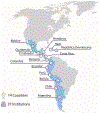Connecting Clinical Capacity and Intervention Sustainability in Resource-Variable Pediatric Oncology Centers in Latin America
- PMID: 38566954
- PMCID: PMC10987010
- DOI: 10.1007/s43477-023-00106-2
Connecting Clinical Capacity and Intervention Sustainability in Resource-Variable Pediatric Oncology Centers in Latin America
Abstract
Clinical capacity for sustainability, or the clinical resources needed to sustain an evidence-based practice, represent proximal determinants that contribute to intervention sustainment. We examine the relationship between clinical capacity for sustainability and sustainment of PEWS, an evidence-based intervention to improve outcomes for pediatric oncology patients in resource-variable hospitals. We conducted a cross-sectional survey among Latin American pediatric oncology centers participating in Proyecto Escala de Valoración de Alerta Temprana (EVAT), an improvement collaborative to implement Pediatric Early Warning Systems (PEWS). Hospitals were eligible if they had completed PEWS implementation. Clinicians were eligible to participate if they were involved in PEWS implementation or used PEWS in clinical work. The Spanish language survey consisted of 56 close and open-ended questions about the respondent, hospital, participants' assessment of clinical capacity to sustain PEWS using the clinical sustainability assessment tool (CSAT), and perceptions about PEWS and its use as an intervention. Results were analyzed using a multi-level modeling approach to examine the relationship between individual, hospital, intervention, and clinical capacity determinants to PEWS sustainment. A total of 797 responses from 37 centers in 13 countries were included in the analysis. Eighty-seven percent of participants reported PEWS sustainment. After controlling for individual, hospital, and intervention factors, clinical capacity was significantly associated with PEWS sustainment (OR 3.27, p < .01). Marginal effects from the final model indicate that an increasing capacity score has a positive influence (11% for every additional CSAT point) of predicting PEWS sustainment. PEWS is a sustainable intervention and clinical capacity to sustain PEWS contributes meaningfully to PEWS sustainment.
Conflict of interest statement
Conflict of interest We have no known conflict of interest to disclose.
Figures




References
-
- Agulnik A, Antillon-Klussmann F, Soberanis Vasquez DJ, Arango R, Moran E, Lopez V, Rodriguez-Galindo C, & Bhakta N (2019). Cost–benefit analysis of implementing a pediatric early warning system at a pediatric oncology hospital in a low-middle income country. Cancer, 125(22), 4052–4058. 10.1002/cncr.32436 - DOI - PubMed
-
- Agulnik A, Cárdenas A, Carrillo AK, Bulsara P, Garza M, Alfonso Carreras Y, Alvarado M, Calderón P, Díaz R, de León C, del Real C, Huitz T, Martínez A, Miralda S, Montalvo E, Negrín O, Osuna A, Perez Fermin CK, Pineda E, … Group ES (2021a). Clinical and organizational risk factors for mortality during deterioration events among pediatric oncology patients in Latin America: A multicenter prospective cohort. Cancer, 127(10), 1668–1678. 10.1002/cncr.33411 - DOI - PMC - PubMed
-
- Agulnik A, Ferrara G, Puerto-Torres M, Gillipelli SR, Elish P, Muniz-Talavera H, Gonzalez-Ruiz A, Armenta M, Barra C, Diaz R, Hernandez C, Juárez Tobias S, de Jesus Loeza J, Mendez A, Montalvo E, Penafiel E, Pineda E, & Graetz DE (2022a). Assessment of barriers and enablers to implementation of a pediatric early warning system in resource-limited settings. JAMA Network Open, 5(3), e221547. 10.1001/jamanetworkopen.2022.1547 - DOI - PMC - PubMed
-
- Agulnik A, Garza M, Gonzalez-Ruiz A, Carrillo A, Conde T, Soberanis D, Rivera J, Martinez A, Villanueva E, Alfonso Y, Alvarez S, Barragán M, Calderon P, Chavez M, Fernández G, Fing E, Huitz T, Juarez S, Miller K, … Rodriguez-Galindo C (2021b). O059/#669: Model for regional collaboration in quality improvement: Implementation of a pediatric early warning system in 17 pediatric oncology centers in Latin America and the Caribbean. Pediatric Critical Care Medicine, 22(Supplement 1 3S), 36. 10.1097/01.pcc.0000738340.70592.e2 - DOI
-
- Agulnik A, Gonzalez Ruiz A, Muniz-Talavera H, Carrillo AK, Cárdenas A, Puerto-Torres MF, Garza M, Conde T, Soberanis Vasquez DJ, Méndez Aceituno A, Acuña Aguirre C, Alfonso Y, Álvarez Arellano SY, Argüello Vargas D, Batista R, Blasco Arriaga EE, Chávez Rios M, Cuencio Rodríguez ME, Fing Soto EA, … Group, the E. de V. de A. T. (EVAT) S. (2022b). Model for regional collaboration: Successful strategy to implement a pediatric early warning system in 36 pediatric oncology centers in Latin America. Cancer, 128(22), 4004–4016. 10.1002/cncr.34427 - DOI - PMC - PubMed
Grants and funding
LinkOut - more resources
Full Text Sources
